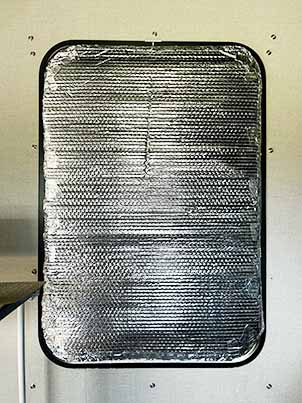Propane is a convenient and cost effective way to make RV living more enjoyable and comfortable. The many RV appliances that utilize propane include the furnace, stove top, oven, refrigerator, water heater, outdoor grill and fireplace. Using propane in an RV has several benefits. It’s easy to refill, convenient to use and is cost effective. The price of propane is cheap compared with the price of electricity.
However, the expense of running propane over time does add up. And it can run out sooner than you think. Because an RV doesn’t have a permanent connection to propane (like a house would have to natural gas), this creates an issue if propane refill locations are not readily available in your location.
The best ways to save propane are to improve the thermal efficiency of your RV, use an alternate energy source (electricity), and ration propane by altering your lifestyle. Finding ways to save propane will extend the time between refills, reduce the change of running out, and help lower costs.
Improve Thermal Efficiency of Your RV
In colder climates, the RV furnace consumes more propane than every other appliance. During the fall, winter and spring when outdoor temperatures are cooler, the RV furnace will need to run often to keep the RV warm. But there are ways to heat your RV more efficiently, thereby reducing how often the furnace needs to run.
Here are six ways to improve thermal efficiency of your RV:
Stop drafts with weather stripping or caulking
Outside cold air is always looking to get into your RV. Window and door seals often have a gap in the seal, or be poorly sealed, allowing cold air to enter. Drafts created by poor seals should be stopped so the furnace doesn’t have constantly battle against the cold air.
A good way to find drafts is to slowly make your way around the entire RV, placing your hand up against every window and door seal and feeling for cold air entering. Another method is to hang short lengths of toilet paper near potential draft areas to see if any airflow moves the paper.
You can also purchase an inexpensive temperature reader that can be used to discover drafts. My recommended temperature reader is the Etekcity Infrared Thermometer 774. It’s inexpensive, very accurate and easy to use.
Once you locate the gaps causing the drafts, seal those gaps with weather stripping or caulking. One great option is the Frost King Indoor & Outdoor B2 Mortite Caulking Cord. It’s very versatile and effective in stopping drafts. I have used this to seal the gaps in my RV.
Insulate your RV windows
Another way that outside cold air impacts the RV indoor temperature is through chilling the glass of the windows. If you place your hand on an RV window pane on a colder day, you can feel just how cold the glass can get. All those cold windows cool down the same indoor air that the furnace is trying to warm up.
You can lessen the impact of cold windows by insulating them on the inside. I recommend using a 3M Window Insulator Kit. It’s easy to install and well worth the money.
Another option to insulate your RV windows is to cut pieces of Reflectix or SmartSHIELD Reflective Insulation and place them over the windows. The Reflectix or SmartSHIELD will help buffer the cold that is coming off of the window glass. You can attach the insulation using velcro strips.

If you plan to RV in colder climates for long periods of time, consider installing double pane windows. The double pane windows have a greater thermal barrier, reducing thermal transfer from the outside.
If you already own an RV, you’ll have to do a cost benefit analysis before replacing your single pane windows. The money you’d save in propane may not be worth the cost of window replacements. If you are shopping for an RV, look for units that already have factory installed double pane windows.
Insulating your RV windows or installing double pane windows will also improve efficiency during the warmer seasons. With the extra thermal barrier, the air conditioning units won’t run as often. While this won’t save propane, it will save electricity.
Use skirting around the RV
If you are in a colder climate and will be stationary for a while, use insulation skirting around the RV to insulate the underside of the RV and keep cold air from passing under your floor. Some RVers create their own skirting using the same SmartSHIELD Reflective Insulation material used to insulate RV windows. Complete skirting kits can also be purchased, such as the ones found at ezsnapdirect.com. It’s not cheap compared to a DIY solution.
Position your RV to take advantage of sunlight
On sunny days, take advantage of the heat of the sun by positioning your RV so the sunlight shines through your windows for much of the day. When choosing your site, select one that receives sunlight during the day instead of one that is shaded by trees. You can use Google maps to help you choose sites that receive sunlight throughout the day. You will be able to see trees that may shade your site.
Heat only the areas of the RV you are using
At night, close the vents in your living area to direct all furnace heat to your sleeping area. Separate your colder living area from your warmer sleeping area by hanging a curtain or blanket if you do not have a door.
Install a programmable thermostat
Replacing your manufacturer thermostat with a programmable one allows you to adjust the RV temperature throughout the day and night. The thermostat can be programmed to lower the temperature setting when you are sleeping or away from the RV.
A popular programmable thermostat that works with many RVs is the Honeywell Home RTH221B1021/E1 RTH221B1021 Programmable Thermostat. However, it does not work with all RVs, so make sure you check the compatibility with your existing wiring prior to purchasing.
After you have improved thermal efficiency, consider using an alternate energy source (electricity) instead of propane.
Use An Alternate Energy Source (Electricity)
Supplement your propane furnace with electric heaters
When electric power is available (shore power or generator), you can supplement the furnace with electric heaters. Make sure to only buy heaters that have safety features such as auto shut off if tipped over and keep them away from flammables. Heaters use significant wattage when running, so pay attention to where they’re plugged in so you don’t overload wiring and fuses.
Run hybrid appliances on electric power
Several RV appliances are able to run on both electric power and propane. They are called hybrid appliances. The most common hybrid appliances are the water heater and the refrigerator. Whenever electric power is available (shore power or generator), make sure to switch all hybrid appliances from propane to electric power. Some appliances will automatically switch when they sense that electric power is available. But if they don’t switch, it’s important to manually do so to avoid using propane unnecessarily.
Always pay attention to which power source your refrigerator is running off of (propane, DC electric, AC electric), especially if you are manually selecting the power source. You might accidentally leave it on electric when disconnecting your RV from shore power, which might drain the RV battery (or truck battery if towing).
Ration Propane By Altering Your Lifestyle
Turn down or turn off the propane fireplace
If your RV is equipped with a propane fireplace, sitting by it on a colder night can be quite enjoyable. However, the fireplace drains a significant amount of propane when used too often. While it’s tempting to keep the fireplace on, resist the urge to use it too frequently.
Lower your thermostat
By lowering your thermostat, the furnace will not run as frequently, reducing the amount of propane used. To counter the lower temperature, wear clothing in layers or add an extra blanket at night. The colder indoor temperature may take some getting used to.
Change how you prepare meals
Assuming you have a propane stop top and/or oven, you can use alternate cooking methods to reduce propane usage. If you prepare hot meals using propane on a day to day basis, it’s easy to run through quite a bit.
When you have electric power, use an instant pot or an electric skillet instead of the propane stove top. Many side dishes can be heated or steamed using a microwave. You can also use other small appliances such as a small air fryer instead of the full size oven.
When electric power isn’t available, plan meals that don’t require propane to cook. You can use a portable outdoor grill or fire.
If you need to heat up water for coffee or tea, use an electric kettle.
Reduce RV hot water usage
Whenever electric power is not available and you need to run your water heater on propane, you should use less hot water to keep the water heater from running as long. Run the faucet less and use lukewarm water when washing dishes.
Take shorter (sailor) showers and turn off the water while soaping up and shampooing. While the water is hot, schedule back-to-back showers for family members at the same time of the day so your water heater doesn’t have to constantly run for hours at a time.
Conclusion
By improving the thermal efficiency of your RV, using an alternate energy source (electricity), and altering your lifestyle, you will be able to save both time and money.
Related Questions
What RV Appliance Uses the Most Propane?
RV furnaces use more propane than all other RV propane appliances. This is especially true in colder climates. The average RV furnace uses 30,000 BTUs of propane, which can drain the average RV propane tank(s) quickly throughout colder overnights. If you are curious about how to calculate your RV’s propane BTU usage, read my article How Long Does RV Propane Last?
Should I Carry a Backup Propane Tank In My RV?
A backup propane tank is highly recommended, especially if you are in a cold climate and depend on propane to operate. The backup tank gives you a buffer if you accidentally leave a propane appliance running or miscalculate propane usage.

